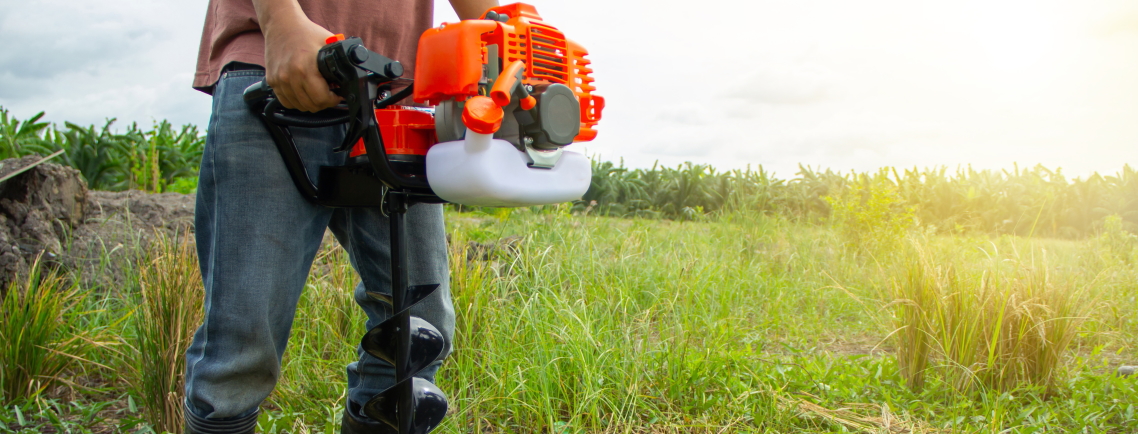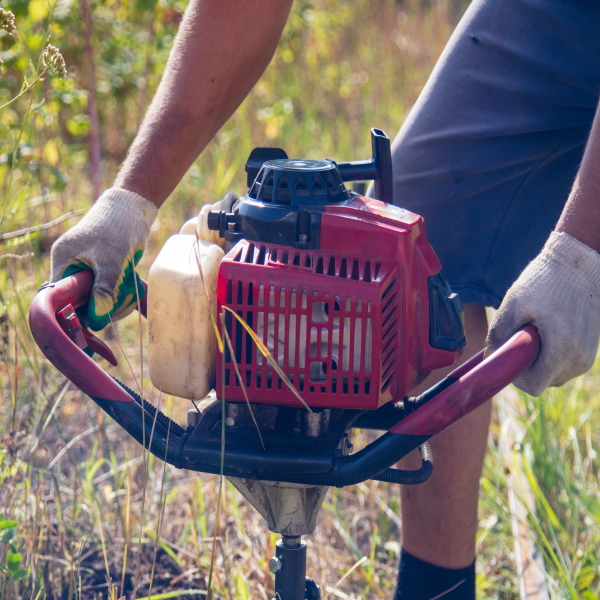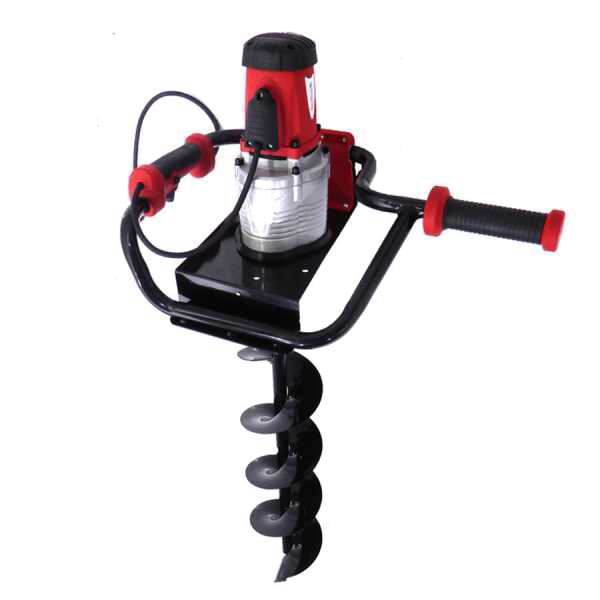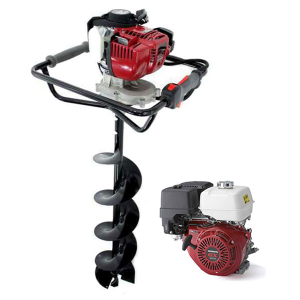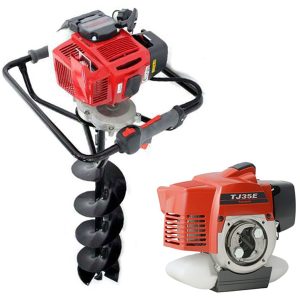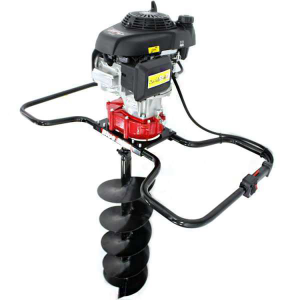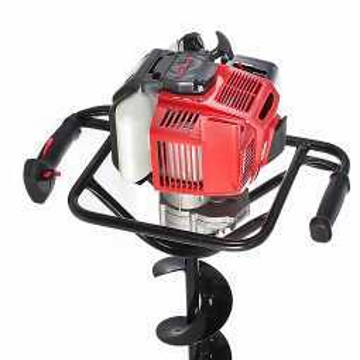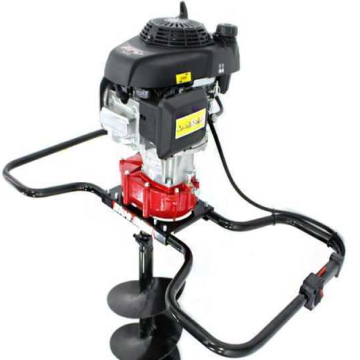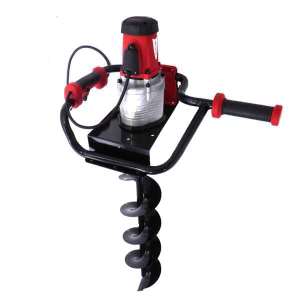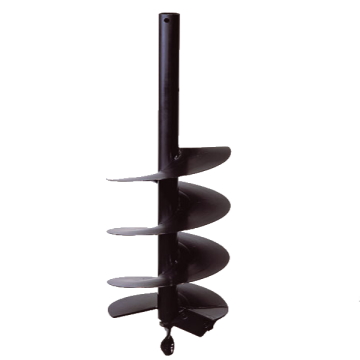A comprehensive guide to buying motorised augers, providing you all the knowledge you need.
The Complete Guide to help you choose the Best Post Hole Borer
by the Real Experts of Equipment for Soil Tilling and Care
The post hole borer is the conventional tool that is used to drill into solid or semi-solid material, thanks to a propeller that rotates on its axis, thus extracting the material and creating a drilling hole. They are used for soil preparation, reforestation, planting fruit trees even on steep slopes and are also widely employed in the construction industry. But how to choose the best earth auger? Finding the right product is not easy, but with this purchasing guide we will hopefully give you all the information you need.
There are many factors to take into consideration in order to purchase the most suitable post hole borer, such as:
- Frequency of use
- Engine power
- Diameter of the holes
- The type of soil where the drilling will be performed
The body of the earth auger is divided into simple sections:
- The engine or the motor
- The auger bit
- The handlebar

The engine or the motor 
The auger bit 
The handlebar
First of all, it should be pointed out that there are 3 different types of earth augers:
- Manual earth augers

2/4-stroke Engine post hole borer 
Electric post hole borer 
Manual earth auger
Thanks to this purchasing guide, you will be able to find your way around when choosing the best earth auger. We will mainly focus on 2/4-stroke engine and electric models as they are the most widespread on the global market.
2. 2/4-stroke Engine post hole borers
2/4-stroke Engine earth augers are the most popular among professionals who expect excellent and time-saving results, as they are the most powerful and high-performing. They prove to be very useful for those who own a large piece of farmland and need to stack poles and plant large plants, as well as for those who need to carry out work on the road surface.

Because they have more power, compared to electric ones, they are used on hard ground that is difficult to work, thus making drilling easier. They feature in both the hobby range and in the heavy-duty one The former retain a good level of performance and reliability, ideal for those who do not use them regularly or are new to farm work.
They are mostly used on soils of limited size, made up of sandy material and without the presence of stones. The latter, on the other hand, offer unmatched performance and are the most popular among users who need to operate them on a continuous basis and demand excellent results. They are used on large terrain that is difficult to work.
Heavy-duty earth augers are fitted with engines of the highest quality and efficiency, and those boasting these features are Honda or Kawasaki branded.
2.1. Honda petrol engine
Honda engines, generally of 4-stroke type, are characterised by reliability superior to any competitor in the field. Immediate and functional starting, low compression, high engine speed and the possibility of topping machinery with petrol without the need to prepare oil-fuel mix, make these engine types the best choice for a high quality product. These powerful engines provide for:
- 50% lower fuel consumption than 2-stroke engines
- 70% lower pollutant emissions compared to 2-stroke models
- 30% less noise compared to 2-stroke models
- 40% less vibration than 2-stroke engines
Honda engines are made to last for a long time, the high quality materials used are designed and built to ensure optimal functionality over an extended service life.
2.2. Kawasaki 2-stroke engines
Kawasaki engines has a strong focus on excellence and innovation, earning a reputation as one of the highest quality and most reliable engine suppliers in the world. Machinery powered with original Kawasaki 2-stroke engine are the most advanced on the market today, due to the outstanding efficiency achieved in every possible aspect:
- High rpm rate
- Highest power output in their class
- Renowned Kawasaki reliability
- Unmatched weight/power ratio
- Lower fuel consumption than competitors
- Quick and handy start
- Reduced compression at start-up thanks to KAR system
- Reduced polluting emissions
- Low noise emissions levels thanks to SQS muffler technology
3. 2/4-stroke Engine
As mentioned above, there are engine-powered post hole borers fitted with both 2-stroke and 4-stroke engines. There are obviously advantages and disadvantages to both types. The choice of engine depends mainly on the intended use and work requirements.
2-stroke or 4-stroke engine?
3.1. 2-stroke Engine earth augers
They are undoubtedly the most common and most sought-after engine solution for users. What are their real benefits?
- Greater power with the same displacement
- Greater suitability to professional use
- Higher torque than 4-stroke engines
- Low weight and easy handling
- Constructive simplicity
- Easier maintenance*
*In this respect, we suggest you read our Guide to 2-Stroke Engine Maintenance, for more information about the descriptive details of this type of engine.

On the other hand, it should be said that there are also disadvantages to 2-stroke engines:
- The preparation of fuel-oil mix
- Higher specific consumption
- More vibrations
- Higher emissions and more smoke, which can be an obstacle to the user’s work
- Higher noise levels as the engine has higher rpms
3.2. 4-stroke Engine earth augers
The 4-stroke engine is technically more complex than the 2-stroke one: its cycle is developed in two crankshaft rotations and takes place in four stages.
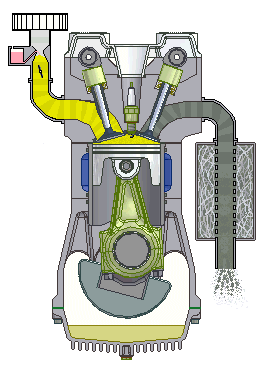
- intake
- compression
- combustion
- exhaust
Despite the greater complexity of construction and operation, it still has certain advantages:
- High fuel efficiency
- Lower fuel consumption for the same displacement compared to 2-strokes
- Reduced harmful emissions
- Lower noise levels
- Less vibrations
We must underline, however, that the 4-stroke engine has a less “rapid” operation than 2-stroke ones, in addition to:
- Lower power
- Increased weight
- Less durability than 2-strokes
CONCLUSIONS:
For professional use, a 4-stroke engine post hole borer is a good choice, as, in addition to providing higher performance and exceptional ergonomics, it has the advantage of an extremely easy-to-use engine that does not require fuel-oil mix preparation. A 2-stroke hobby-range earth auger, on the other hand, represents the right choice for all users who need to carry out small regular drilling works and are looking for a more comfortable and easy-to-use machine.
| Features: | 2-stroke | 4-stroke |
|---|---|---|
| More power | ✔ | ❌ |
| Higher torque | ✔ | ❌ |
| Lower weight | ✔ | ❌ |
| Long-term durability | ✔ | ❌ |
| Less vibrations | ❌ | ✔ |
| Less smoke | ❌ | ✔ |
| Lower noise levels | ❌ | ✔ |
| Easy start-up | ❌ | ✔ |
| Ease of use | ❌ | ✔ |
| Fuel simplicity | ❌ | ✔ |
4. Post hole borers with inverter
In the category of 4-stroke engine earth augers, the ones equipped with an inverter stand out as highly professional products. These post hole borers mount very powerful engines which allow large diameter holes to be drilled in soils of different densities. They are employed for stacking street lighting poles, fences and palisades for pillar bases. The gearbox of these earth augers is equipped with an inverter mechanism. By engaging it, it is possible to change the rotation of the auger bit in the opposite direction. It proves to be very useful for drilling with large auger bits, because if there is no possibility of lifting the bit from the hole in the worked soil, the reverse rotation is an essential feature that can easily solve this problem: once the direction of rotation has been changed, the auger bit can be easily removed from the ground.
5. The handlebar
The best 2/4-stroke engine post hole borer should not only be powerful, but also comfortable to use. A key feature is the ergonomic handles and, of course, the weight of the earth auger itself. The post hole borer in operation produces strong vibrations that are spread by the motor and the movement of the auger bits.
There is obviously a difference in weight between a 2-stroke and a 4-stroke earth auger and this affects the correct functioning of the tool.
The former will certainly be much lighter and more comfortable to use, even by a single operator, while the latter, with its much heavier engine, will require two or more operators. For long and frequent working sessions, we recommend post hole borer models that feature the handle separated from the engine to reduce the annoying effect of vibrations.

Single handle 
Handlebar
In order to ensure correct use and a long service life, the machine must be checked regularly for maintenance. The air filter, cylinder fins and spark plug must be cleaned and replaced if damaged.
6. Electric post hole borers
Unlike 2/4-stroke engine post hole borers, electric earth augers certainly deliver much less power and are intended for a limited variety of jobs.
For the use of these post hole borers, it is necessary to have a nearby electrical source, which means that they can not be used in open fields.
They turn out to be suitable for small drilling works mostly located around the home. In addition, electric post hole borers drill smaller holes than the more powerful 2/4-stroke types.
However, electric post hole borers have the advantage of very low maintenance compared to 2/4-stroke earth augers. They are suitable for beginners, for first uses of an earth auger, and for those who are looking for ease of use and low maintenance requirements.
7. Manual earth augers

The manual earth auger, as the name suggests, has no engine, needs neither fuel nor electricity, and requires only physical strength to be used.
They are mostly used for special sowing on soft, preferably sandy soils and for very limited drilling work.
7. Earth auger bits
Last but not least, the post hole borer bit plays a key role in drilling the ground.
It is extremely important to take into account the size of the pole to be staked, because the auger bit must always be larger in diameter, so that there is space around it to fill with soil and press it in.
Normally the auger bit on a post hole borer can reach a depth of 800 mm, although many have an extension attachment that allows to go as deep as 1200 mm.
When the pitch is too large for the size of the thread, other threads, called “starts”, can be added.
We can identify two different types of auger bits:
- single-start auger bit
- double-start auger bit
Single-start auger bits consist of a sheet of metal that twists around the shaft, while double-start auger bits feature two sheets of metal that wrap around the shaft in a parallel and evenly spaced configuration.

Single-start auger bit 
Double-start auger bit
Certainly, double-start post hole borer bits allow for a faster, more regular and more precise drilling.
We therefore invite you to take this purchasing guide as a starting point and carefully analyse all the various models on the basis of the information we have given you in order to make the best choice suited to your needs.



